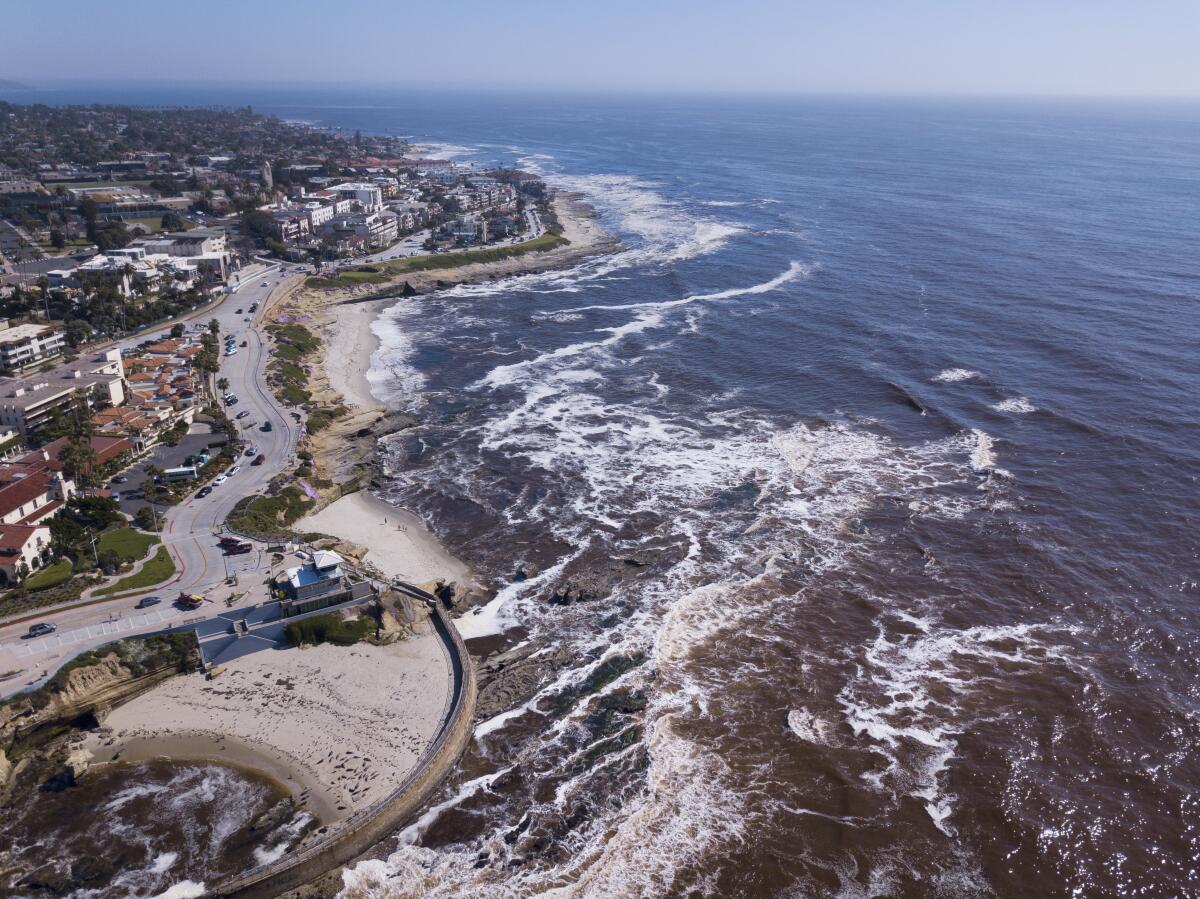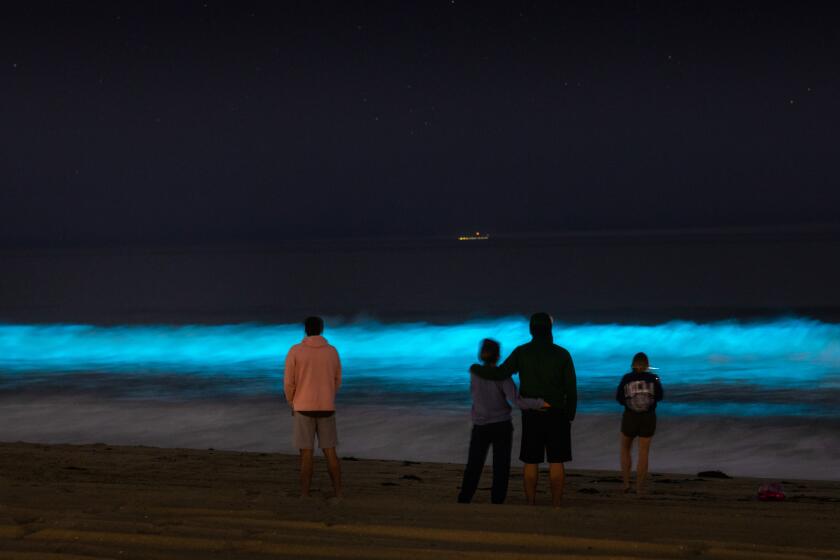Neon blue flash gives way to rotting stench as red tide sweeps California coast

- Share via
As if to celebrate the reopening of Southern California beaches, the Pacific Ocean threw a party, complete with a light show.
Then it left behind a smelly mess of dying algae.
The microorganisms produce stunning bioluminescence that has illuminated the surf up and down the coast for several weeks. Red tides occur when they reproduce en masse, staining seawater rusty brown with as many as 20 million cells per liter.
A photochemical reaction in the cells when they are jostled by waves emits a flash of electric blue, in a sort of southern, aquatic version of the aurora borealis. As the bloom dies out, however, the unpleasant scent of decay can travel miles from shore.
“The smell is because the red tide is breaking down,” said Michael Latz, a biologist with Scripps Institution of Oceanography, in San Diego. “When it reaches its final phase, then it’s going to die off. The organisms, as they break open and die, they’re releasing organic material into the water. And also, there are bacteria that are feasting on that organic material, and they’re releasing odors.
“You put it all together and you have the breakdown of the red tide producing odors, and the bacteria producing odors, and it makes it very stinky.”
The phenomenon was caused by a red tide produced by recent rains.
The “sulfurous, rotten, decaying” stench has remarkable staying power as it wafts inland on sea breezes, Latz said.
“I’m a mile and a half inland,” he said. “I smell it here.”
Some kinds of red tide produce toxins that are harmful to sea creatures and humans, Latz said, but these events aren’t poisonous, just putrid. Nonetheless, some people are sensitive to the fumes, and may develop rashes or respiratory irritation, he said.
Matt O’Malley, executive director of San Diego Coastkeeper, counts himself as one of those unfortunates, and said his eyes tear up when he catches a whiff of the malodorous microorganisms.
“I live a mile and a half away, and I can smell it very strong at night, to the point that my wife and I thought something died in my backyard,” he said.
Along Coast Highway, the smell ebbs and flows, growing stronger in some stretches, and fading at others. It can be particularly strong at lagoons, where fish die-offs have followed the algal bloom and bust. As bacteria devour the remains, they deplete oxygen and essentially suffocate other creatures.
Video and photos show an algae bloom in the South Bay producing a neon-blue light along the shoreline at night in Hermosa Beach.
“They’re very metabolically active through their respiration, and they use up a lot of oxygen,” Latz said. “So especially in enclosed areas or the bottom of the ocean where that settles out, that causes extremely low oxygen levels that can be harmful to other animals, especially fish. We’ve heard reports of fish kills, and dead fish washing up on beaches and coastal lagoons.”
Across Los Angeles County, coastal residents have also bemoaned the tide’s stinky aftereffects. From Hermosa Beach to Venice and further up the Santa Monica Bay, folks have kept their windows shut and wondered when the rotten smell would go away. Some in Redondo Beach have reported seeing dead fish surfacing in King Harbor.
The length and density of this red tide have been unusual, and local environmental groups have been flooded with messages from the community. Nancy Shrodes, Heal the Bay’s associate director of policy and outreach, said this week has provided a good opportunity to educate the public about this natural phenomenon.
“People have been very much intrigued and engaged with us on this issue,” she said.
Last week, the smell was strong in South Carlsbad, and then abated a bit in Leucadia. Moonlight Beach in Encinitas exuded a briny, metallic tang, rather than the full stench of decomposition. Although the water was an unsettling shade of brownish orange, beachgoers took advantage of the newly reopened beaches to walk, wade and swim.
“It was kind of normal,” said Warren Galvin, 12, of Point Loma, who visited Moonlight Beach with his family.
The red tide hasn’t deterred the family from their neighboring beach either, said his mother, Lorraine Galvin.
“It’s been red tide at Ocean Beach, and we have been swimming and surfing,” she said. “My mom lives in Carlsbad and she said it was pretty pungent.”
Also at issue have been rafts of seaweed washing ashore during the red tide event. Scripps researcher Ed Parnell said he doesn’t think the red tide would significantly affect giant kelp, though it may crowd out sunlight from lower growing species of seaweed. However, he said, the most likely causes of the seaweed piles would be the recent swell, which prunes older or poorly anchored plants, or spring tides associated with the full moon.
“Seaweed wrack has a fortnightly cycle of moving up and down the shoreline in blobs of rotting tissue,” he said. “Extreme high tides associated with spring tides wash it high up onto the beach where it sits and decays until the next set of spring tides wash it back into the ocean where the blobs gets moved somewhere else and stranded.”
The red tide cycle has generated both natural wonder and nuisance for many Californians who are itching to emerge from quarantine to enjoy the outdoors.
Beachgoers reveled in the luminescent waves over the past week or two, which happily coincided with beach reopenings of many coastal cities starting around May 1, after more than a month of COVID-19 closures. Los Angeles County beaches, which have been closed since late March, are set to reopen soon, albeit with some new rules.
Now that the weather is warmer and social distancing rules are relaxed enough to allow beachgoers to walk, swim or surf, it’s frustrating to some that the ocean is serving up a stinky stew.
“Certainly at a time when there are so many stressors, we want to take advantage of our beautiful coastline, but the smell and the irritability [that it creates prevent that],” O’Malley said. “At a time when a lot of us are looking to get back out and take advantage of the recreational opportunities our coast provides, there is limited availability.”
Brennan writes for the San Diego Union-Tribune. Times staff writer Rosanna Xia contributed to this report.
More to Read
Sign up for Essential California
The most important California stories and recommendations in your inbox every morning.
You may occasionally receive promotional content from the Los Angeles Times.












